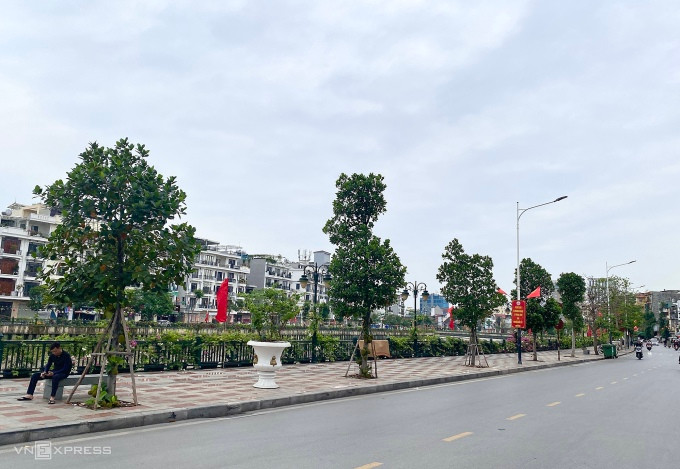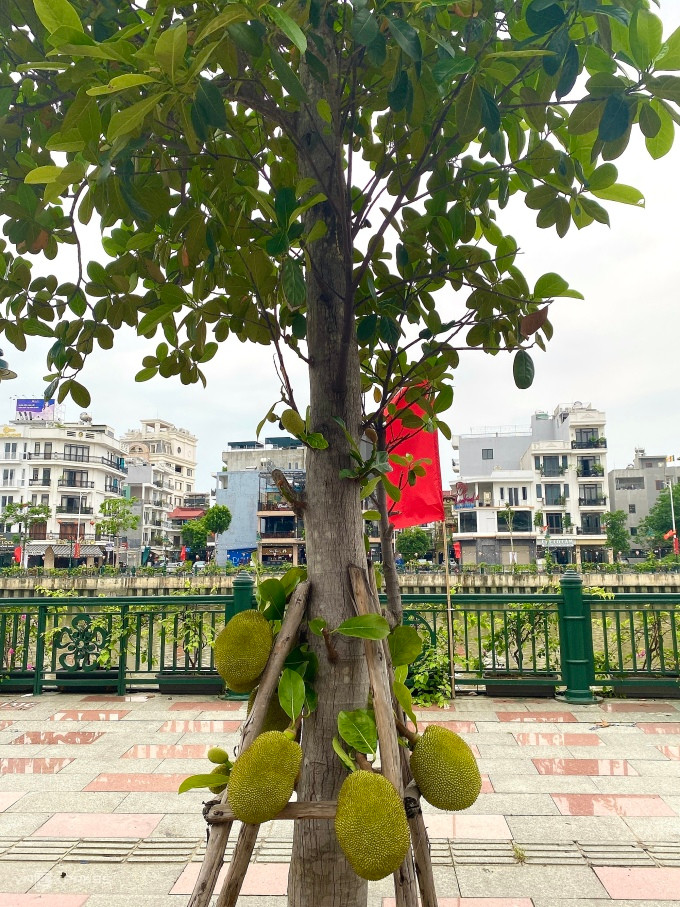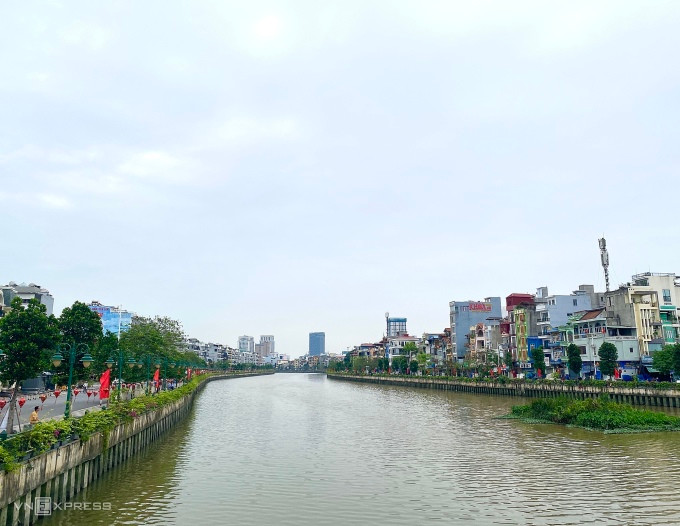Jackfruit trees planted along Tam Bac Street, Hong Bang District, are laden with fruit, making many people excited, but many are concerned that the trees' branches are easily broken and the fruit is stolen.

Huyen My, 30 years old, living in Dong Khe ward, Ngo Quyen district, is surprised every time she goes to work through Tam Bac street, Ha Ly ward, because many jackfruit trees 3-5 m high, planted along the sidewalk, have started to bear fruit. Many trees have more than a dozen small fruits hanging close to the base.
The first time she saw fruit trees planted on the sidewalk, My said she liked the new landscape. Last weekend she also invited her friends to take pictures. "This change is very interesting, the feeling of seeing the trees bearing fruit makes me feel that the place I live is greener and more peaceful," My said.
Two rows of jackfruit trees were planted along the Tam Bac River from 2022, replacing the dead poplar trees on The Lu walking street, Ha Ly ward. There are about 150 trees on both sides of the sidewalk around the riverbank, more than one kilometer long, on The Lu and Tam Bac streets. Many trees have borne fruit since 2023. In addition, other streets in Ngo Quyen, Hai An, and Le Chan districts also have many fruit trees such as mango, jackfruit, and star apple, mixed with regular urban trees.
These fruit trees appeared when Hai Phong implemented a project to plant 5,000 new trees. In addition to jackfruit, there are also rice, queen bauhinia, Osaka, royal poinciana, and mango. At a regular press conference at that time, city leaders said that the trees planted had been carefully researched, could withstand storms, and were healthier than royal poinciana trees, which had been planted for many years. The new trees were planted in each area, tested for effectiveness, and then expanded, which also brought diversity to the city's green tree system.
Since the day the jackfruit trees were planted on the sidewalk in front of his house, Mr. Van Tuan, 65 years old, living on Tam Bac Street, Ha Ly Ward, said he was grateful to the city for giving his place a "new look". The man who opened a car repair shop at home said that since the jackfruit trees were planted, dozens of people have come to take pictures every day.
Recently, when the jackfruit trees began to bear fruit, some posts on social networks created a lot of controversy. Some people supported planting fruit trees in public places because they wanted to increase the green area, create a landscape and possibly create a food supply. Others opposed planting fruit trees because they were concerned that if the trees broke, the fruit would fall on people and cause danger. Many people wondered "who will the fruit belong to when harvested?".
Mr. Tuan affirmed that he and the people living here do not steal. "Spending a few tens of thousands of dong can buy a kilo of peeled jackfruit, but if you get caught stealing, where can you hide?", the 65-year-old man said. He also said that the trees are planted in front of his house, so he is more conscious. If he sees anyone trying to steal them, he reminds them, hoping to preserve the landscape.
Ms. Ngoc Ha, 40 years old, a sanitation worker on this street, said that last year some jackfruit trees bore fruit, but before they could be harvested, they were all stolen. Residents and sanitation workers around the area kept watch, but it was ineffective.
Ms. Nguyen Thi Ngoc Bich, Chairwoman of the People's Committee of Ha Ly Ward, Hong Bang District, said that planting fruit trees on the streets of the ward is a policy of the city, and the tree company is responsible for taking care of them. "People living around the street also actively help units protect the trees," Ms. Bich said.

Supporting the planting of fruit trees interspersed with royal poinciana, lagerstroemia, and mahogany to help stratify and green the city, Mr. Thanh Tung, 50 years old, in Dang Hai ward, Hai An district, is concerned that fruit trees have brittle branches that break easily, especially during storms and tornadoes. Social networks have shared a number of cases where vehicles parked on the roadside or on the sidewalk were hit by falling jackfruit and mango, causing property damage.
"These are all public trees. If something falls on them, who will I ask for compensation? It's best not to plant fruit trees on the street. They should only be planted in parks and areas with few people and vehicles," said Mr. Tung.
Dr. Truong Van Vinh, deputy head of the Forestry Department at Ho Chi Minh City University of Agriculture and Forestry, said that people's concerns are well-founded. The choice of trees to plant in urban areas or on roads depends on many factors such as climate conditions, soil, sidewalk area, drainage system, electrical system as well as construction architecture. The government needs to conduct careful research and plan appropriately to ensure effectiveness and promote the full role of trees, but at the same time, ensure the safety of human life and property.
According to Mr. Vinh, planting fruit trees in public places has four major disadvantages. First, ripe fruit falling on the road can cause slippery, dangerous for people and pollute the environment. Fruit can attract insects such as mosquitoes, ants, bees, affecting people's lives. In addition, some fruit trees have very toxic latex, for example mango trees, latex can burn the skin, very difficult to clean when it gets on clothes or cars parked under the tree canopy. And finally, the size of fruit trees and their exposed, widespread root system and susceptibility to pests and diseases, should not be planted in urban areas, parks and streets.

In response to people's concerns, the Hai Phong Department of Construction affirmed that shade trees, fruit trees, and flowering trees planted during this period all have tenacious vitality, straight trunks, wide canopies, and year-round green leaves.
Dr. Truong Van Vinh said that Vietnam is a tropical country, with more than 2,500 species of woody plants, so it is necessary to select and test suitable species. It is best to prioritize planting perennial, slow-growing, native species. In addition to the functions of urban trees, the development of native species also plays a role in preserving and maintaining rare genetic resources, increasing diversity, contributing to environmental protection, raising community awareness and educating the younger generation about the value of nature.
Architect Dao Ngoc Nghiem, Vice President of the Vietnam Urban Planning and Development Association, also said that the planning for trees planted in public places does not prohibit the planting of fruit trees, but it still needs to be limited, depending on the planting location and accompanying conditions.
"Units need to examine and check the necessary and sufficient conditions for planting, and at the same time must get people's opinions and consent instead of planting whatever they want," said Mr. Nghiem.
Mr. Thanh Tung said that although the model of planting combined with beautifying the landscape, he still worries every time he moves under the rows of fruit trees. He said he always tells his family members not to park near the base of the trees, and to choose roundabout routes to avoid the trees on rainy and windy days.
"It's beautiful but full of danger, better safe than sorry," said Mr. Tung.
TH (according to VnExpress)